
Recipe: How to make the most of these bonus babies
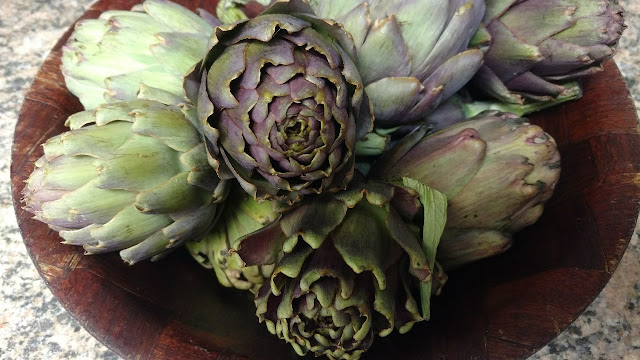 |
| "Baby" artichokes are just petite full-grown artichokes. They can be used in all kinds of recipes. (Photos: Debbie Arrington) |
It’s been a great spring for artichokes. In Sacramento gardens, these oversized thistles have been especially productive, pumping out gobs of globes.
But what do you do with all those “baby” artichokes? Preparing these bonus babies takes work, but they’re all heart.
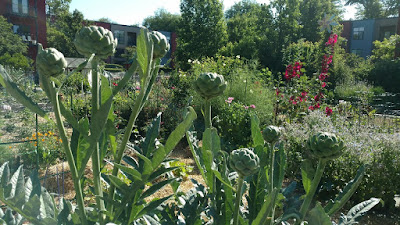 |
| All those baby artichokes are actually fully developed and mostly heart. |
These small side buds aren’t actually “baby” artichokes; they’re fully developed, just petite. The good news: Most of them contain little if any choke – those prickly hairs that cover the meaty heart.
An abundance of small artichokes drove me to look for ways to prepare and save them for later. (Italian cooks have been doing this for centuries.) Here are some short cuts:
When cut, artichokes turn black quickly. To keep them green, set up a large bowl of water. Cut a lemon in half. Add the juice of one half lemon to the water. Keep the other lemon half handy for treating the artichokes while trimming.
With every slice, rub the cut surface with the lemon. When finished trimming, drop the artichoke into the lemon water. Keep it there until ready to steam.
With a sharp knife, cut off the stem close to the base. Treat the cut with lemon. Tear off the tough outer leaves, one by one. They’ll snap at the base, keeping the meat attached to the heart.
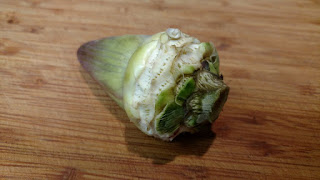 |
| The outer petals have been removed from this artichoke. |
Once the outer leaves are removed, cut the remaining leaves close to the heart. Again, treat the cut with lemon.
Cut the heart in half (if large, in fourths), treating each cut side with a rub of lemon. With a spoon, scoop out any choke. Put cut hearts in lemon water until ready to process.
When working with the individual artichokes, be careful of thorns. Heirloom artichoke varieties in particular have long needles on the end of each petal. Use scissors or a sharp knife to cut off the petal ends first before attempting to pull them off. Your hands will thank you.
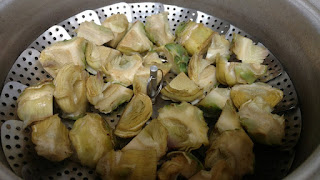 |
| Prepared artichoke hearts go into the steamer. |
Once the artichoke hearts are cut up, remove them from the lemon water and steam them for 8 to 10 minutes, or until tender when poked with a sharp knife.
The hearts are now ready for any recipe that calls for artichoke hearts. (They can be frozen for later use, too.) Marinate them for salads. Add to chicken breasts or toss with pasta.
My favorite: Fried artichoke hearts. This Italian recipe, from Mark Bittman’s excellent globe-trotting collection, is a lot healthier than those deep-fried State Fair nuggets, but just as satisfying.
Fried artichoke hearts
Adapted from “The Best Recipes in the World” by Mark Bittman (Broadway Books)
Makes 4 servings
Ingredients:
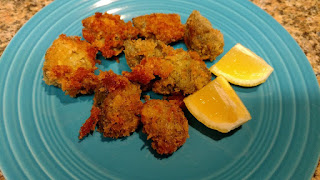 |
| Fried artichoke hearts make a great appetizer. |
Comments
0 comments have been posted.Sacramento Digs Gardening to your inbox.
Food in My Back Yard Series
May 6: Maintain soil moisture with mulch for garden success
April 29: What's (already) wrong with my tomato plants?
April 22: Should you stock up on fertilizer? (Yes!)
April 15: Grow culinary herbs in containers
April 8: When to plant summer vegetables
April 1: Don't be fooled by these garden myths
March 25: Fertilizer tips: How to 'feed' your vegetables for healthy growth
March 18: Time to give vegetable seedlings some more space
March 11: Ways to win the fight against weeds
March 4: Potatoes from the garden
Feb. 25: Plant a fruit tree now -- for later
Feb. 18: How to squeeze more food into less space
Feb. 11: When to plant? Consider staggering your transplants
Feb. 4: Starting in seed starting
Sites We Like
Garden Checklist for week of May 11
Make the most of the lower temperatures early in the week. We’ll be back in the 80s by Thursday.
* Plant, plant, plant! It’s prime planting season in the Sacramento area. Time to set out those tomato transplants along with peppers and eggplants. Pinch off any flowers on new transplants to make them concentrate on establishing roots instead of setting premature fruit.
* Direct-seed melons, cucumbers, summer squash, corn, radishes, pumpkins and annual herbs such as basil.
* Harvest cabbage, lettuce, peas and green onions.
* In the flower garden, direct-seed sunflowers, cosmos, salvia, zinnias, marigolds, celosia and asters. (You also can transplant seedlings for many of the same flowers.)
* Plant dahlia tubers.
* Transplant petunias, marigolds and perennial flowers such as astilbe, columbine, coneflowers, coreopsis, dahlias, rudbeckia and verbena.
* Keep an eye out for slugs, snails, earwigs and aphids that want to dine on tender new growth.
* Feed summer bloomers with a balanced fertilizer.
* For continued bloom, cut off spent flowers on roses as well as other flowering plants.
* Add mulch to the garden to maintain moisture. Mulch also cuts down on weeds. But don’t let it mound around the stems or trunks of trees or shrubs. Leave about a 6-inch-to-1-foot circle to avoid crown rot or other problems.
* Remember to weed! Pull those nasties before they set seed.
* Water early in the day and keep seedlings evenly moist.